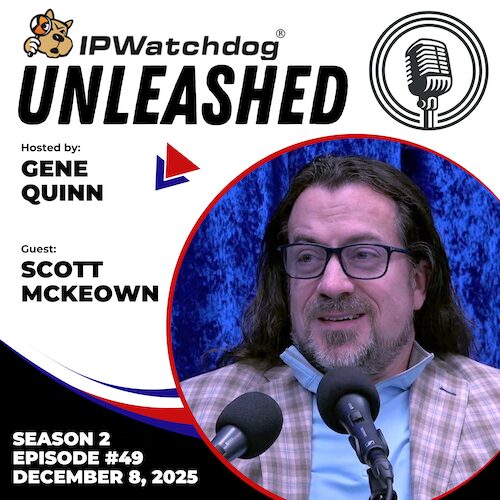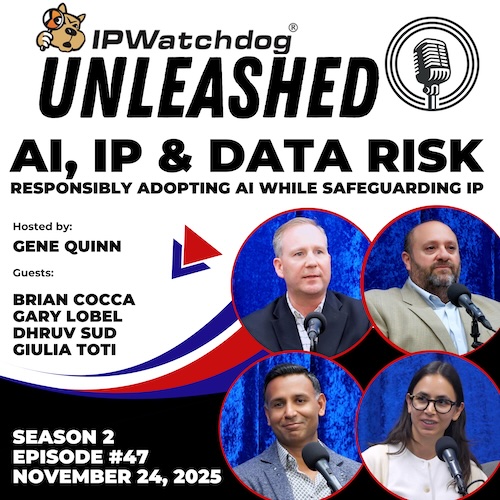Posts in IP News
The U.S. Court of Appeals for the Federal Circuit (CAFC) on Wednesday issued a precedential decision affirming the Trademark Trial and Appeal Board’s (TTAB’s) cancellation of the registration for the mark I AM MORE THAN AN ATHLETE. GP GAME PLAN. The CAFC also dismissed Game Plan, Inc.’s opposition to Uninterrupted IP, LLC’s (UNIP’s) six intent-to-use applications for marks containing I AM MORE THAN AN ATHLETE and MORE THAN AN ATHLETE. The opinion was authored by Judge Reyna.
The Senate Subcommittee on Intellectual Property held a hearing on Tuesday that included testimony from the band Kiss’s co-founder, Gene Simmons, to discuss issues surrounding a proposed bill to compensate performers when their songs are broadcast on terrestrial radio stations. “America remains the only democratic nation and one of the few countries globally that does not compensate performers or copyright holders when their songs are played on AM/FM radio,” said IP Subcommittee Chair Thom Tillis (R-NC).
The U.S. Court of Appeals for the Federal Circuit (CAFC) on Tuesday issued a precedential decision in International Business Machines Corporation v. Zillow Group, Inc., affirming a Patent Trial and Appeal Board (PTAB) ruling that certain claims of an IBM patent on single sign-on (SSO) technology were unpatentable, while others were not. The CAFC found no fault with the PTAB’s claim construction or its analysis of the prior art and rejected IBM’s argument that the Board relied on a theory not raised in the initial petition for inter partes review (IPR).
Verisign’s Law Department is seeking an attorney to support a variety of intellectual property-related functions, with a focus on patent development and prosecution, open source licensing, IP, technology, and AI counseling to our business and other attorneys. This position is based in our Reston, VA office and offers a hybrid work schedule.
There’s a lot going on at the Patent Trial and Appeal Board (PTAB) right now, and it’s not just the usual noise about discretionary denial. The United States Patent and Trademark Office (USPTO) has published a one-and-done rules package that, if it survives, would fundamentally change how inter partes review (IPR) challenge works, who can challenge patents, and when. The comment window on the proposed one-and-done rule has now closed. With more than 10,000 comments received by the USPTO and over 700 individual commenters weighing in, the proposed rules package has become a flashpoint for questions that go way beyond discretionary denial and AIA trials, with many asking whether the USPTO is functionally trying to engage in de facto legislation to neuter the PTAB.
The U.S. Court of Appeals for the Federal Circuit (CAFC) today issued three decisions denying mandamus relief to inter partes review (IPR) petitioners at the Patent Trial and Appeal Board (PTAB) whose petitions were denied institution.
The U.S. Court of Appeals for the Federal Circuit (CAFC) issued a precedential decision today authored by Chief Judge Moore reversing the Trademark Trial and Appeal Board’s (TTAB’s) affirmance of a refusal to register the mark KAHWA for cafes and coffee shops.
The U.S. Court of Appeals for the Federal Circuit (CAFC) on Monday affirmed a district court’s summary judgment of non-infringement and judgment as a matter of law (JMOL) in Shopify Inc. v. Express Mobile, Inc., confirming the rejection of a $40 million jury verdict against Shopify. Shopify filed a declaratory judgment action in the U.S. District Court for the District of Delaware, seeking a declaration of noninfringement of the claims of U.S. Patent Nos. 9,063,755, 9,471,287, 6,546,397, and 7,594,168, which relate to website design and functionality. Express Mobile counterclaimed for infringement of those patents and additionally asserted U.S. Patent No. 9,928,044 by accusing Shopify’s Theme Editor and its underlying “Liquid” template technology.
Today, the U.S. Court of Appeals for the Federal Circuit issued a precedential ruling in Coda Development S.R.O. v. Goodyear Tire & Rubber Co. affirming the Northern District of Ohio’s post-verdict grant of judgment as a matter of law (JMOL) to Goodyear on state trade secret and federal inventorship claims raised by Coda. The Federal Circuit ruled that Coda’s trade secret claims were either not defined with sufficient particularity or were publicly disclosed in patent applications filed by Coda, leading the appellate court to dismiss the appellant’s correction of inventorship claims as well.
What’s really holding America back in the biopharma race against China isn’t just Beijing’s subsidies or cheaper labor. It’s the U.S. Court of Appeals for the Federal Circuit’s self-inflicted wound: a court so panel-dependent that no one—brand or generic—knows which rule will apply until the panel is drawn. The Supreme Court can fix this in one stroke by granting certiorari in MSN Pharmaceuticals v. Novartis (No. 25-225) and killing the bizarre “after-arising technology” exception that lets old, vague patents swallow future inventions.
The U.S. Supreme Court today declined to grant a petition filed by Recentive Analytics, Inc. asking the Court to weigh in on whether the U.S. Court of Appeals for the Federal Circuit’s (CAFC’s) approach to patent eligibility for machine learning claims is improper. The petition was filed in October following an April 2025 decision by the CAFC that addressed an issue of first impression in the patent eligibility context; the opinion held that “claims that do no more than apply established methods of machine learning to a new data environment” are not patent eligible.
On December 5, The New York Times Company (the Times) filed a complaint for copyright and trademark infringement against Perplexity AI, Inc. in the U.S. District Court for the Southern District of New York, adding another major lawsuit to the growing wave of litigation against generative artificial intelligence (AI) companies. The Times alleged in its filing that Perplexity engaged in “large-scale, unlawful copying and distribution” of millions of its articles to build its AI-powered “answer engine.” The complaint argued that Perplexity’s products directly substitute for the newspaper’s own content, thereby undermining its business and devaluing its journalism. Perplexity’s conduct “threatens this legacy and impedes the free press’s ability to continue playing its role in supporting an informed citizenry and a healthy democracy,” the Times argued.
The U.S. Court of Appeals for the Federal Circuit (CAFC) on Friday vacated and remanded a district court’s decision in favor of Meta, rejecting the court’s finding that patent owner Adnexus had failed to state a plausible claim for direct infringement. The decision was precedential and authored by Judge Stark, with whom Judges Taranto and Prost joined.
This week in Other Barks & Bites: The U.S. Patent and Trademark Office announced it has updated the Manual of Patent Examining Procedure to reflect recent eligibility guidance; The New York Times has sued Perplexity AI for copyright and trademark infringement; AGs from seven U.S. states sent a letter to the College Sports Commission calling out its “cartoonishly villainous” university participation agreement; and more.
The United States Patent and Trademark Office (USPTO) today released two memos meant to provide additional guidance around the use of patent subject matter eligibility declarations (SMEDs) for examiners, applicants and practitioners, particularly with respect to “applied technologies” in areas like artificial intelligence and medical diagnostics. The memos do not alter existing procedures and are effective immediately.

Latest IPW Posts
CAFC Affirms TTAB’s Cancellation of Nonprofit’s Marks for Fundraising Services
December 10, 2025 @ 06:16 pmSenate IP Subcommittee Hears from Witnesses on Impact of Proposal to Compensate Artists for Radio Plays
December 10, 2025 @ 01:15 pmFederal Circuit Affirms PTAB’s Mixed Decision on IBM Single Sign-On Patent Claims
December 10, 2025 @ 10:26 amUnderstanding IP Matters: Taming the Wild West of AI
December 10, 2025 @ 07:15 amVerisign is Seeking an In-house IP/Patent Attorney
December 10, 2025 @ 05:15 am
Latest Podcasts


![[IPWatchdog Logo]](https://ipwatchdog.com/wp-content/themes/IPWatchdog%20-%202023/assets/images/temp/logo-small@2x.png)
![[Advertisement]](https://ipwatchdog.com/wp-content/uploads/2025/12/Harfang-IP-Dec-11-2025-sidebar-700x500-1.jpg)
![[Advertisement]](https://ipwatchdog.com/wp-content/uploads/2025/11/Juristat-Ad-Firm-Cost-Management-Nov-18-Dec-31-2025-Animated-Varsity-Ad-final.gif)
![[Advertisement]](https://ipwatchdog.com/wp-content/uploads/2025/11/PTAB-Masters-2026-sidebar-early-bird-700x500-1.jpg)
![[Advertisement]](https://ipwatchdog.com/wp-content/uploads/2025/12/LIVE-2026-sidebar-early-bird-new-700x500-1.jpg)





![[Advertisement]](https://ipwatchdog.com/wp-content/uploads/2021/12/WEBINAR-336-x-280-px.png)
![[Advertisement]](https://ipwatchdog.com/wp-content/uploads/2021/12/Ad-4-The-Invent-Patent-System™.png)
